Clay minerals
-
Introduction
-
Lattice structure of silicate minerals
a) Formation of Si-O-Si bridges
-
Systematics of silicate minerals
a) Isomorphous substitution
-
2-layered and 3-layered clay minerals
a) Kaolinite
b) Smectite
c) Illite
Introduction
-
Primary minerals are chemically not modified since deposition
and crystallization from lava. Through weathering and soil forming process, the
chemical composition of the primary minerals is altered and secondary minerals
are formed. The major processes during weathering leading to the formation of
secondary minerals are:
-
Modification (alteration) of the structure
-
Complete dissolution (decomposition) in ions and colloidal
decomposition products
-
Recombination of clay minerals from dissolved weathering
products (very slow process)
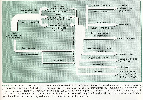 |
| Fig.1 Weathering and clay minerals |
| (
Source: Brady and Weil, 2002.) |
-
Of particular interest in Soil Science are: silicate minerals,
oxides, carbonates, phosphates and sulfides. In this section we will focus on
silicate minerals. Pictures on primary minerals please click
 here here
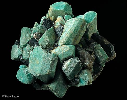 |
| Fig.2 The two most common minerals in the Earth's crust.
Crystals of feldspar (green) and quartz (gray) from Pikes Peak, Colorado. This
specimen is 20 cm across. |
|
Lattice structure of silicate minerals
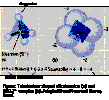 |
| Fig.3 Si-tetrahedron |
| (
Source: Adopted from Press and Siever, 1996.) |
-
Fig.3: Tetrahedron-shaped silicate anion (a) and
[SiO4]4- complex
(b).
Si-tetrahedron:
Further informations at
 www.gly.uga.edu/schroeder/geol6550/CM06.html www.gly.uga.edu/schroeder/geol6550/CM06.html
-
The basic module of all silicate minerals is a tetrahedron. The
smaller Si-Ion in the center is associated with O-atoms and forms the
SiO44- complex. The
[SiO4]4- tetrahedron is an
anion with 4 negative charges and needs to be counter-balanced by 4 positive
charges either through binding with cations and formation of Si-O-Si bridges
where the O-ions are shared with other Si-tetrahedrons.
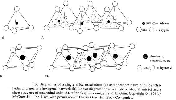 |
| Fig.4 Silica tetrahedra |
| (
Source: http://www.origins.rpi.edu/claycatalyzed.html) |
Octahedron
-
Larger cations like Al3+,
Fe2+ and Mg2+ are
associated with 6 O- or OH-ions and form an eight-sided octahedron.
 |
| Fig.5 Octahedron |
| (
Source: Brady and Weil 2002, p. 322.) |
-
When 3 Mg2+-atoms are coordinated
with the 6 O/OH ions the sheet is called a tri-octahedral sheet.
-
When the 6 O/OH ions are coordinated with 2
Al3+-atoms the sheet is called
di-octahedral.
-
The negative surplus charge of an octahedron is ¾ of the total
charge, for example
[AlO6]9-.
-
Similar to the Si-tetrahedron, the negative surplus charges are
counter-balance through cations or higher-level structures.
Formation of Si-O-Si bridges
-
The silicate minerals are composed of sheets which are held
together by joint O-atoms. This leaf-like or plenar structure is termed
phyllosilicates.
-
Adjacent tetrahedrons share 3 O-atoms
[Si2O5]2-
and adjoining octahedrons share 3 OH-ions
[Al(OH)3].
-
Based on the layer sequence one distinguishes between 1:1
two-layer minerals or 2:1 three-layer minerals. In the interlayers are adsorbed
cations and water.
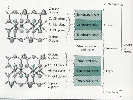 |
| Fig.6 Si-O-Si bridges |
| (
Source: Brady and Weil 2002, p. 322.) |
Systematics of silicate minerals
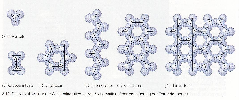 |
| Fig.7 Polymerization of common silicate
minerals |
| (
Source: Press and Siever 1995, p. 37.) |
-
The diversity of silicate minerals is based on 3
properties:
-
Polymerization: Si-O-Si (see fig.7)
-
Formation of multiple salts
-
Isomorphous substitution (see below)
-
Based on the basic structure silicates are divided into 6
groups (see fig.8).
 |
| Fig.8 Basic systematic structure of
silicates |
|
Isomorphous substitution
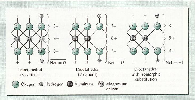 |
| Fig.9 Isomorphic substitution |
| (
Source: Brady and Weil 2002, p. 323.) |
-
The isomorphous substitution in the crystal lattices of clay
minerals: one atom or element fills a position usually filled by another of
similar size without alteration or modification of the lattice structure (see
fig.9 above).
-
It takes place at the formation of minerals from lava flux
(not afterwards during weathering) due to deficiency or surplus of individual
elements in the lava flux. The molecules fit by magnitude (size) but, posses a
different charge.
-
However, as the number of O- or OH-ions in the tetrahedron or
octahedron is fixed, negative surplus charges are generated. Hence neutralizing
(counter-balancing) cations are inserted. They determine the cation-exchange
capacity
(
 CEC)
and the nutrient
availability of soils. CEC)
and the nutrient
availability of soils.
-
Note: the charge deficit is permanent in the sense that it is
a structural feature of the clay particle and persists irrespective of changing
conditions such as soil pH and soil solution composition.
2-layered and 3-layered clay minerals
Kaolinite
 |
| Fig.10 Tetrahedral and octahedral sheets |
| (
Source: Brady and Weil 2002, p. 325.) |
-
Kaolinite is a 2-layer clay mineral (1:1). Alternating
tetrahedral and octahedral sheets are stacked on top of one another (see
fig.10).
-
The OH of the O-sheet in one layer are adjacent to the O of
the T-sheet of the next layer. Adjacent layers of kaolinite are bound together
by
 hydrogen
bonding (O.....OH). hydrogen
bonding (O.....OH).
-
Because of the interlayer
 hydrogen
bonding, the structure of kaolinite is fixed and no
expansion takes place when clay is wetted. Therefore cations and water do not
enter between the structural layers. This results in: hydrogen
bonding, the structure of kaolinite is fixed and no
expansion takes place when clay is wetted. Therefore cations and water do not
enter between the structural layers. This results in:
-
the effective surface is restricted to the external surface
area
-
lack of significant isomorphous substitution and hence low
net negative charge and small capacity to adsorb exchangeable cations.
-
Kaolinite is the single most occurring clay mineral and is
the end product of weathering. Kaolinite is prevalent in many tropical
soils.
-
Example of low or non isomorphous substitution of kaolinite
and the calculation of the net charge is given below:
| Example: | |
 |
| Fig.11 Charge characteristics of
kaolinite |
| (
Source: Juma 2002, p. 186.) |
|
Smectite
-
The 2:1 type clay minerals are composed of one octahedral
sheet sandwiched between two tetrahedral sheets. Four general groups of
silicate clays have this basic crystal structure:
-
smectite (montmorillonite) expanding-type
-
vermiculite
-
fine micas (illite) none-expanding
-
chlorite
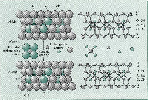 |
| Fig.12 Smectite |
| (
Source: Brady and Weil 2002, p. 327.) |
-
The top and bottom planes of each layer consist of O-atoms
and the adjacent layers are only loosely bound by very weak O-O or
O-cation-bridges (see fig.12).
-
Therefore, exchangeable cations and water easily can enter
the interlayer spaces which may result in interlayer expansion. This leads
to:
-
High plasticity
-
Problems in land use: sticky and wet during rainy season and
hard and soil cracks during dry season
-
Change in volume: swelling-shrinking
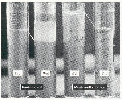 |
| Fig. 13 The different swelling tendencies of
kaolinitic (left) and montmorillonitic clay (right) is illustrated. All 4
cylinders initially contained dry, sieved clay soil. An equal amount of water
was added to the 2 center cylinders, termed “wet”. The kaolinitic soil settled
a bit and was not able to absorb all the water. The montmorillonitic soil
swelled about 25 % in volume and absorbed nearly all the added
water. |
| (
Source: R. Weil, University of Maryland, USA.) |
-
But also: very high total specific surface area
-
Smectites have a high negative net charge through isomorphous
substitution of mainly Mg2+ for
A3+ in the octahedral sheet.
-
The exchange capacity is 20-40 times higher than of
kaolinites.
-
The predominant formation of smectites occurs through
weathering of basic igneous rocks and volcanic ashes, if Mg is
present/available. Weathering products in semi-arid regions and lower landscape
positions (accumulation of Mg).
-
An example of the isomorphous substitution of montmorillonite
and the calculation of the net charge is depicted in fig.15:
| Example: | |
 |
| Fig.15 Charge characteristics of
montmorillonite |
| (
Source: Juma 2002, p. 187.) |
|
Micas (Illite)
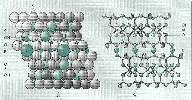 |
| Fig.16 Illite |
| (
Source: Brady and Weil 2002, p. 329.) |
-
Illites have isomorphous substitution in the tetrahedron but
little or none in the octahedron (see fig.16 above).
-
K-ions are present in the interlayer. The ionic radius of K
fits snugly into the hexagonal holes between the tetrahedral oxygen groups.
Thus adjacent tetrahedral sheets are strongly bound together, preventing the
type of expansion that characterizes smectite clays.
-
The behave more like kaolinite than smectites with regard to
adsorbing water and cations. This takes place mainly at the external
surfaces.
-
An example of the isomorphous substitution of illites and the
calculation of the net charge is presented in fig.17:
| Example: | |
 |
| Fig.17 Formula illite |
| (
Source: Juma 2002, p. 189.) |
|
|

 previous | next
previous | next

 previous | next
previous | next